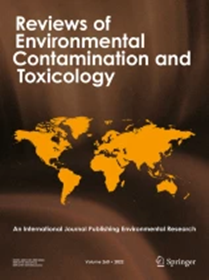Consequences of Microplastics on Global Ecosystem Structure and Function
IF 6.6
3区 环境科学与生态学
Q1 ENVIRONMENTAL SCIENCES
Reviews of environmental contamination and toxicology
Pub Date : 2023-09-11
DOI:10.1007/s44169-023-00047-9
引用次数: 0
Abstract
Microplastics (MPs) are a class of pollutants that can persist for centuries, entering global ecosystems in large amounts. Previous studies have focused on the toxicological effects of MPs on single species or population scales from a narrow ecotoxicological perspective, while the systemic effects of MPs on the structure and function of global terrestrial and aquatic ecosystems are still unknown. In this review, we describe the fate and trophic transfer of MPs in ecosystems, which determines the possible scenarios of their interaction with ecosystems, highlighting the alteration of ecosystem structure and function by MPs. The presence of MPs in ecosystems changes the physicochemical properties of the abiotic environment and the habitat of organisms; these particles then directly or indirectly interact with organisms, leading to toxicological and ecological effects. Importantly, MPs, as a new global pressure, likely affect essential biogeochemical processes such as carbon and nitrogen processes. In addition, MPs affect energy flow by interfering with processes such as energy fixation and transfer in primary producers, energy acquisition, consumption and distribution in consumers, and energy metabolism in decomposers. The effects of MPs on information exchange alter the growth, development, and reproduction of organisms, as well as intraspecific and interspecific relationships. At the same time, as vectors for other global pollutants and pathogens, MPs influence their global transport patterns and pose a significant ecological risk. Early understanding of the toxic costs of MPs from the perspective of ecosystem structure and function is essential to maintain the homeostasis and stability of global ecosystems.微塑料对全球生态系统结构和功能的影响
微塑料(MPs)是一类可以持续几个世纪的污染物,大量进入全球生态系统。以往的研究多集中于从狭窄的生态毒理学角度研究MPs对单个物种或种群的毒理学效应,而对全球陆地和水生生态系统结构和功能的系统性影响尚不清楚。在本文中,我们描述了MPs在生态系统中的命运和营养转移,这决定了它们与生态系统相互作用的可能情景,重点介绍了MPs对生态系统结构和功能的改变。MPs在生态系统中的存在改变了非生物环境的物理化学性质和生物体的栖息地;然后,这些颗粒直接或间接地与生物体相互作用,导致毒理学和生态效应。重要的是,MPs作为一种新的全球压力,可能影响基本的生物地球化学过程,如碳和氮过程。此外,MPs通过干扰初级生产者的能量固定和转移、消费者的能量获取、消耗和分配以及分解者的能量代谢等过程来影响能量流。MPs对信息交换的影响改变了生物体的生长、发育和繁殖,以及种内和种间关系。同时,作为其他全球污染物和病原体的载体,MPs影响其全球运输模式,并构成重大生态风险。从生态系统结构和功能的角度及早认识MPs的毒性成本,对于维持全球生态系统的动态平衡和稳定至关重要。
本文章由计算机程序翻译,如有差异,请以英文原文为准。
求助全文
约1分钟内获得全文
求助全文
来源期刊
CiteScore
12.80
自引率
0.00%
发文量
11
审稿时长
>24 weeks
期刊介绍:
Reviews of Environmental Contamination and Toxicology publishes reviews pertaining to the sources, transport, fate and effects of contaminants in the environment. The journal provides a place for the publication of critical reviews of the current knowledge and understanding of environmental sciences in order to provide insight into contaminant pathways, fate and behavior in environmental compartments and the possible consequences of their presence, with multidisciplinary contributions from the fields of analytical chemistry, biochemistry, biology, ecology, molecular and cellular biology (in an environmental context), and human, wildlife and environmental toxicology.
•Standing on a 55+ year history of publishing environmental toxicology reviews
•Now publishing in journal format boasting rigorous review and expanded editorial board
•Publishing home for extensive environmental reviews dealing with sources, transport, fate and effect of contaminants
•Through Springer Compact agreements, authors from participating institutions can publish Open Choice at no cost to the authors

 求助内容:
求助内容: 应助结果提醒方式:
应助结果提醒方式:


